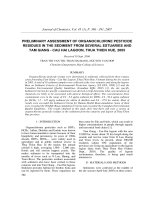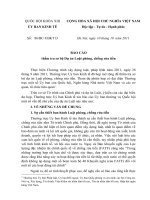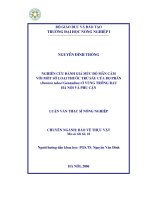Thẩm tra sơ bộ thuốc trừ sâu clo hữu cơ
Bạn đang xem bản rút gọn của tài liệu. Xem và tải ngay bản đầy đủ của tài liệu tại đây (131.48 KB, 6 trang )
386
Journal of Chemistry, Vol. 45 (3), P. 386 - 391, 2007
PRELIMINARY ASSESSMENT OF ORGANOCHLORINE PESTICIDE
RESIDUES IN THE SEDIMENT FROM SEVERAL ESTUARIES AND
TAM GIANG - CAU HAI LAGOON, THUA THIEN HUE, 2005
Received 18 Sept. 2006
Tran Thi Van Thi, Tran Hai Bang, Nguyen Van Hop
Chemistry Department, Hue College of Sciences
SUMMARY
Organochlorine pesticide residue were determined in sediments collected from three estuary
zones fowarding Tam Giang - Cau Hai Lagoon, Thua Thien Hue, Vietnam during the dry season
in 2005. A total of 10 sediment samples were collected at the river estuaries and along the lagoon.
Base on Sediment Criteria of Environmental Protection Agency (US EPA, 1999) [1] and the
Canadian Environmental Quality Guidelines (Canadian EQG, 2002) [3], the site specific
Sediment Criterion for specific contaminant was derived to help determine what concentrations of
chemicals are likely to be associated with adverse biological effects. The concentrations these
contaminants were in the range of 0.2 - 8.2
µ
g/kg sediment for DDTs, 4.9 - 92.4
µ
g/kg sediment
for HCHs, 1.5 - 110
µ
g/kg sediment for aldrin & dieldrin and 0.6 - 27.9 for endrin. Most of
results were exceeded the Sediment Criteria for Human Health Bioaccumulation. Some of them
even exceeded the Wildlife Bioaccumulation Criteria and exceeded the Canadian Environmental
Quality Guidelines. The results obtained in this study show that there still exist a variety of
organochlorine pesticide residues in the sediments from the estuaries and lagoon of Thua Thien
Hue province.
I - INTRODUCTION
Organochlorine pesticides such as DDTs,
HCHs, Aldrin, Dieldrin and Endrin were known
to have bioaccumulative nature because of their
lipopilicity and persistency. In years of 1980s
decade, DDTs, HCHs,… were widely used in
agriculture and in public medical service in
Thua Thien Hue. In the region, the annual
rainfall is high, averaging 1,800 - 2,000 mm,
floods and soil erosion happen yearly. This
makes sediment to be transported into the
mouths of rivers such as O Lau, Huong, and
Truoi River. The pesticides residues associated
with sediment also have been carried to these
estuaries and into Tam Giang – Cau Hai lagoon.
Sediment provides habitat for benthic biota and
can be ingested by them. These organisms are
then eaten by fish and birds, which can result in
higher concentrations in people through aquatic
and terrestrial food chains [1].
Tam Giang - Cau Hai lagoon with the area
22,000 ha, locate about 70 km length along the
seaside and receive water from O Lau, Huong
and Truoi rivers At present, about 300,000
residents (about 30% population of the
province) are living on aquaculture in the lagoon
region (data from Thua Thien Hue Fishery
Dept., 2003). The quality of lagoon
environment, therefore, is being paid much
attention to.
II - MATERIALS AND METHODS
Sediments were collected at the middle of
the dry season (April-July 2005) on three zones:
387
- The O Lau estuary next to Tam Giang;
- The Huong estuary next to Tam Giang;
- The Truoi estuary next to Thuy Tu and Cau
Hai.
1. Contaminant analysis
Sampling and sample pre-treatment
At each of 10 sites, several samples were
collected and pooled in order to obtain a
representative sample. The analysis method was
according to US EPA-methods: 3540C, 3620 B,
3660, 3665A, 508 for soxhlet extraction, Florisil
clean- up, sulphur clean-up, sulphuric acid
clean-up and determination for organochlorine
compounds, respectively [2].
Sediment samples were wet sieved through a
metallic screen and the fraction with particle
size < 0.1 mm was used. Samples were kept in a
deep freezer at -20
o
C until analysis.
2 g of sediment was taken and mixed with 2
g of anhydrous Na
2
SO
4
. Sample extraction was
carried out by mixing with 100 ml n-hexane in
soxhlet extractor for 12 hours. The extracts were
concentrated on a rotary evaporator and then
reduced the volume to approximately 2 - 5 ml.
The extracts were treated with activated Cu
powder to remove sulfur compounds, then by
florisil column and follow with H
2
SO
4
before
performing chromatography.
Contaminant quantification
Analyses of the samples were carried out
using a programmed temperature gas
chromatograph equipped with mass
spectroscopy QP-2010-GC-MS with DB-1
column. Quantification of the contaminants is
based on the internal standard method using
pyren-d10. Final results are expressed in dry
weigh basis.
2. Organic carbon analysis
It was carried out using Walkley-Black
method [3]. The sample was reacted in K
2
Cr
2
O
7
1 N and concentrated H
2
SO
4
solution for a half
of hour. The received solution was titrated using
Mohr solution. The concentration of organic
compounds in the sample was derived:
organic compounds (%) = 0.39K (V
0
-V
1
)N
and organic carbon (%) = organic compounds
(%): 2.
in which:
K: dry weigh concentration;
V
0
: the volume of Mohr solution for the
blank sample;
V
1
: the volume of Mohr solution for the
sediment sample;
N: the concentration of Mohr solution;
2: conversion factor.
3. Assessment method
a) The Sediment Quality Criteria
Concentrations of DDTs, HCHs, aldrin and
dieldrin, endrin defined in sediments in some
estuaries were compared with the Sediment
Citeria of Environmental Protection Agency (US
EPA, 1999) [4] and the Canadian Environmental
Quality Guidelines (Canadian EQG, 2002) [5].
The Sediment Criteria have been established for
certain contaminants to help determine what
concentrations of chemicals are likely to be
associated with adverse biological effects.
Within the framework of New York State water
quality regulations, five primary levels of
protection are identified (6NYCRR, 1991).
From which sediment criteria can be derived to
different levels.
Sediment Quality Criteria for Non- Polar
Organic Compounds using Equilibrium
Partitioning (EP) methodology. The basic for EP
methodology is that the toxicity of a
contaminant in sediment is attributable to the
concentration of the contaminant that dissolves
in the interstitial pore water, and is considered
to be freely biologically available [1].
When a non-polar organic contaminant
enters the sediment, it will partition between the
sediment and pore water in three compartments:
a fraction will adsorb to the organic carbon in
the sediment another fraction will adsorb to
dissolved organic carbon in the interstitial pore
water; and a third fraction will dissolve in the
pore water. The equilibrium will be established
so that any change in the contaminant
concentration in one compartment will result in
a corresponding change in the contaminant
concentration in other compartments.
388
b) Accounting
The organic carbon normalized contaminant
sediment criterion SC
O
C
SC
O
C
=WQC × K
O
W
WQC: Water quality criterion for each
contaminant (µg/l) in US Sediment Criteria
K
OW
: the octanol/water partition coefficient,
very similar with sediment organic carbon/water
partition coefficient for a non-polar organic
contaminant (l/kg)
SC
OC
: the organic carbon normalized
contaminant sediment criterion (µg/gOC; OC:
organic carbon)
For example, the DDT Water quality
criterion WQC for the level of protection of
piscivorous wide life from bioaccumulation is
0.001 µg/l, the K
O
W
for DDTs is 10
6
l/kg. The
organic carbon normalized DDTs sediment
criterion SC
OC
would be:
DDT SC
OC
= 0.001 µg/l × 1,000,000 l/kg ×
1kg/1,000 g OC = 1 µg/gOC
(1 kg/1,000 g OC is a conversion factor;
OC: organic carbon)
The meaning of the criterion is that based on
the equilibrium partitioning characteristic of
DDTs, in order not to exceed the water quality
criterion of 0.001 µg/l in the pore water, the
concentration of DDTs in the sediment must not
exceed 1 µg for each gram of organic carbon in
the sediment.
The site specific sediment criterion (SC) for a
contaminant
To apply this SC
OC
on a site specific basis,
the concentration of organic carbon in the
sediment at the site must be know. For example,
if the concentration of DDTs in 1-OL sediment
sample was know to contain 1.62% organic
carbon, the site specific sediment criterion (SC)
for DDT could be derived:
SC = SC
OC
× f
OC
f
OC =
1.62%OC/kg sediment = 16.2 gOC/kg
DDT SC = 1 µg/gOC × 16.2 gOC/kg = 16.2
µg DDTs/ kg sediment
This criterion states that: if there are less
than 16.2 µg DDTs/kg in sediment containing >
1.62% organic carbon, there is no appreciable
risk to piscivorous widelife from consuming fish
or other aquatic life from the water body over
the contaminated sediment.
III - RESULTS AND DISCUSSION
Measured values of oganochlorines was
compared with Sediment Criteia calculated for a
specific site, the results was presented in Fig. 1–
Fig. 4.
For DDTs (Fig. 1)
In mid-1980s, DDTs was heavily used to
control malaria in Thua Thien Hue, especially in
Nam Dong, A Luoi district, upstream of Truoi
River. The high yearly rainfall and erosion can
be the cause of transporting DDTs to the
downstream of Truoi River and entering Cau
Hai lagoon so that the concentration of this
oganochlorine compound is very high here.
• Measured values Human Health Bioaccumulation Benthic Aquatic Life Chronic Toxicity × Widelife Bioaccumulation
1-OL
2-OLTG
3-TG 5-SHTG
4-SH
6-TT
8-STCH
9-CH
7-TTCH
10-TH
0
5
10
15
20
25
30
Figure 1: Measured values of DDTs compared with Levels of US Sediment Criteria
DDT
Sites
µg/kg
389
Once enter to environment DDT can breaks
down to DDE, DDD and some other species,
which are also toxic and resistant. DDTs
detected in all sediment samples were higher
than the Levels of Human Health
Bioaccumulation and Wide life Bio-
accumulation. Total DDT in all samples
exceeded the Sediment Quality Criteria for
Level of Human Health Bioaccumulation about
10 - 80 times. The highest value of DDTs was
8.2 µg/kg at the 9-CH site; the lowest one was
0.2 µg/kg at 4-SH
Canadian Environmental Quality Guidelines
(Canadian EQG, 2002) for DDE in sediment
(probable effect level of 3.74 µg/kg marine
sediment) was exceeded at three of 10 studied
sites (1-OL, 3-TG, 9-CH). In general,
comparing with US EPA 1999 or Canadian EQG
2002, the results show that the residue of DDT
is the risk for environment.
- For HCHs (Fig. 2)
HCHs were very high in samples of 1-OL,
3-TG and 7-TTCH, they exceeded the levels,
except the Level of Benthic Aquatic Life Acute
Toxicity. This is suitable with the fact that
HCHs is a popular pesticide and widely used in
agriculture. Along O Lau River’s banks with 10
km long from upstream to downstream, there is
hundreds of hectare of rice. The use of
agrochemical, especially HCHs, makes this
region be polluted. Although the downstream of
this river was zoning to establish a Bird
Conservation Area, there are some environment
problems that have to be concerned.
The probable effect level of Canadian EQG
2002 was only 0.99 µg/kg marine sediment. All
the measured data of HCH were exceeded from
6 to 90 times (5.56 µg/kg at 2-OLTG to 92.38
µg/kg at 3-TG site).
- For Aldrin &dieldrin (Fig. 3)
Six samples (from 1-OL to 6-TT) in O Lau –
Tam Giang, Huong – Thuy Tu areas, which
have low concentration of these oganochlorine
contaminants, but 4 remain samples (from 7-
TTCH to 10-TH) in Truoi – Cau Hai area that
have very high concentration of these two
contaminants. The sample of 8-STCH contained
the highest of aldrin and dieldrin with 110 µg/kg
sediment. This is an unusual phenomenon.
Although aldrin is used as a termiticide in urban
areas but most of Vietnamese doesn’t have the
habit of using this chemical to protect their
wooden appliances. The analysis results of four
latter stations pose a big question, where is the
source of these contaminants and why their
concentration can high like that. The upstream
of Truoi River belongs to Nam Dong and A
Luoi district, which may be one of the sources
of wood supplier for Thua Thien Hue province.
To protect wood from the damage of termite a
large amount of termiticide must have been
used.
The measured data of these chemicals
exceeded from 34 times higher (at 7-TTCH) to
91 times higher (at 8-STCH) compare with
Human Health Bioaccumulation Criteria Level.
Comparing with probable effect level of
Canadian EQG 2002 was only 0.99 µg/kg
marine sediment, all the values of these four
station exceeded from 17 times (at 10-TH) to
111 times (at 8-STCH).
• Measured values Human Health Bioaccumulation Benthic Aquatic Life Chronic Toxicity × Widelife Bioaccumulation
1-OL
2-OLTG
3-TG 5-SHTG
4-SH
6-TT
8-STCH
9-CH
7-TTCH
10-TH
Figure 2: Measured values of HCHs compared with Levels of US Sediment Criteria
0
20
40
60
80
100
120
HCH
Sites
µg/kg
390
- For Endrin (Fig. 4)
All the data of endrin concentration of 10
sites were presented in Fig. 4. In comparing with
Human Health Bioaccumulation and Wildlife
Bioaccumulation Levels, there are four of ten
results exceeded the criteria. The highest
exceeded level is two times higher than the
criteria. There are four samples in which we can
not detect endrin. The data of endrin show that
this kind of chemical does not pose a potential
risk for the environment.
IV - CONCLUSIONs
1. Most of organo-chlorine pesticide
concentrations in the sediment from the
estuaries in Thua Thien Hue were exceeded the
Sediment Criteria for Human Health
Bioaccumulation Level from US EPA 1999
criteria and Canadian EQG 2002 criteria. Some
of them even exceeded the Wildlife
Bioaccumulation Criteria. There are some
environment problems that have to be
concerned.
2. Contaminant concentrations were
detected low in the sediment from Huong
estuary, but the measured data detected were the
very high at O Lau estuary and Cau Hai estuary.
It is necessary to study in detail in these areas.
This work was supported by Asia Research
Center & The Korea Foundation for Advanced
Studies (KFAS).
REFERENCES
1. Centre of Environmental Chemistry (CEC)
(2000), Worskshop on Management, Use and
Assessment of Environmental Pollution of
Pesticides, Hanoi.
2. EPA method and Guidance for analysis of
organochlorine compounds (1996), 3540C,
3620B, 3660, 3665A, 508 US-EPA method.
0
20
40
60
80
100
120
• Measured values Human Health Bioaccumulation Benthic Aquatic Life Chronic Toxicity × Widelife Bioaccumulation
1-OL
2-OLTG
3-TG
5-SHTG
4-SH
6-TT
8-STCH
9-CH
7-TTCH
10-TH
Figure 3: Measured values of aldrin and dieldrin compared with Levels of US Sediment Criteria
Aldrin & Dieldrin
Sites
µg
/kg
0
5
10
15
20
25
30
0 2 4 6 8 10
Endrin
• Measured values Human Health Bioaccumulation Benthic Aquatic Life Chronic Toxicity × Widelife Bioaccumulation
1-OL
2-OLTG
3-TG
5-SHTG
4-SH
6-TT
8-STCH
9-CH
7-TTCH
10-TH
Figure 4: Measured values of endrin compared with Levels of US Sediment Criteria
µg/kg
Sites









